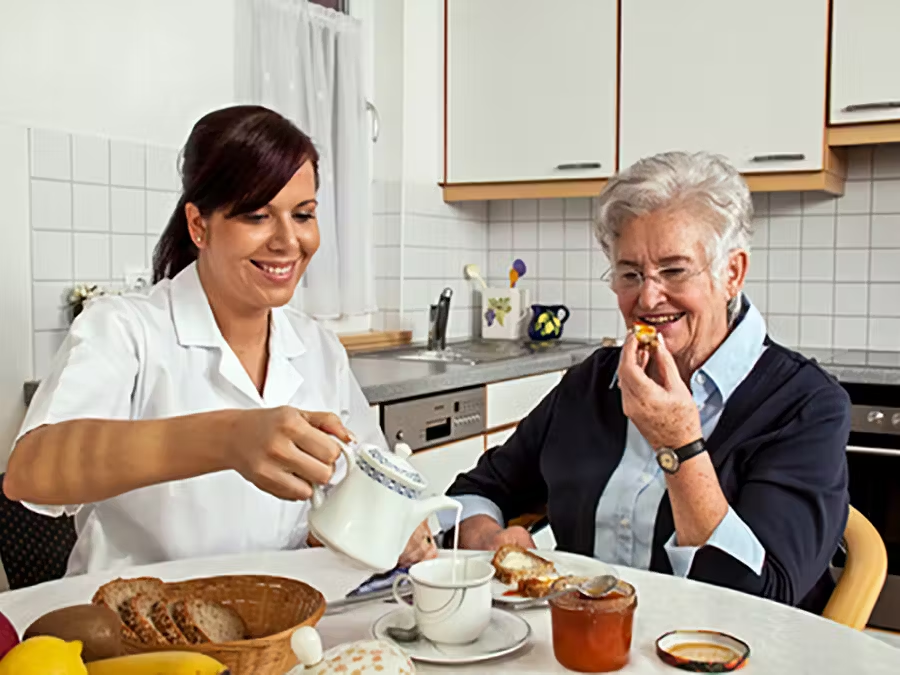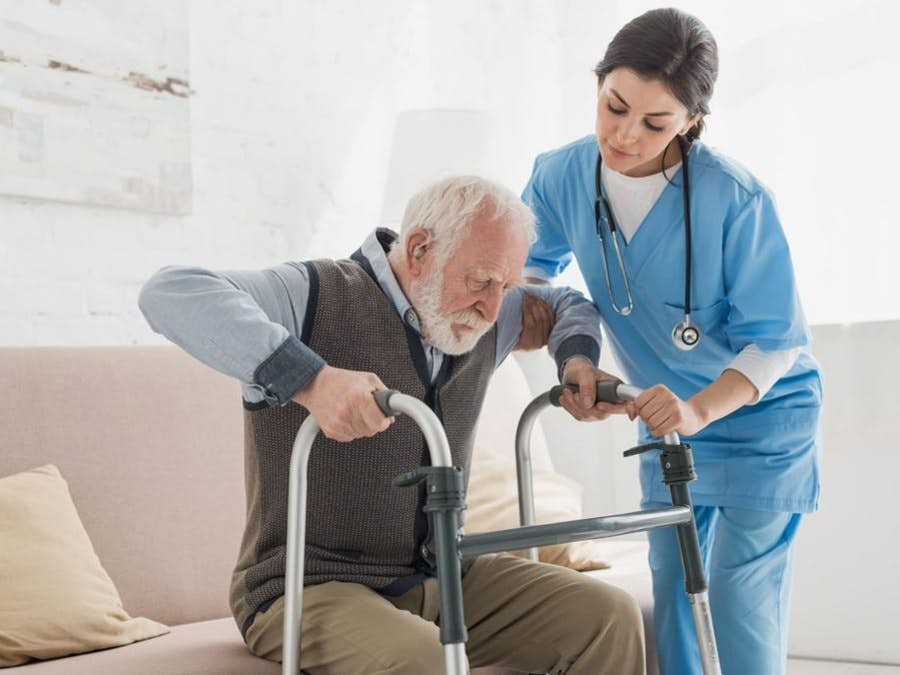.jpg?fit=crop&w=900&auto=format&q=40)
After COVID-19: What Housing for America’s Oldest Could Be Like. Experts and college students studying aging offer their predictions. By Bart Astor July 22, 2020
Share this page:
|
For Seniors

After seeing the heart wrenching images of nursing home residents desperately trying to connect with their families perched outside their windows during COVID-19 and learning about the many deaths in those facilities, it’s quite likely that there will be a sea change in how and where the oldest Americans will live out their lives once the pandemic subsides.
According to the Centers for Disease Control, people over 65 account for a 80% of all COVID-19 deaths and close to half of those were residents in nursing homes or other long-term care institutions.
But if fewer of America’s oldest people will live in nursing homes or assisted living facilities post-pandemic, where and how will they live?
What Students Studying Aging Forecast
For answers, Steve Gurney, publisher of the Positive Aging Sourcebook, asked the students in his School of Aging Studies class at the University of Maryland Baltimore County what they thought.
“I think that this current situation will definitely bring a big change in how families view their elders living with them.”
The comments of these 18-to-25-year-olds were enlightening. As members of Generation Y and Z, they’ll be among the activists who’ll probably lead the charge to a changed America for their parents and grandparents.
A sampling of what the students said:
“We’ve now seen the detrimental effects of having our older loved ones far away from us, either living alone or in assisted living communities.”
“I do believe more families will think about adapting their houses and lifestyle to accommodate older people living with them because living in those nursing facilities is risky.”
“I think that this current situation will definitely bring a big change in how families view their elders living with them. Even as I grow older, and knowing that it may be thirty-plus years until my parents might need end-of-life care, this situation makes me more and more wary of the idea of having them live in a seniors’ facility or even receiving care from someone who’s not in my family.”
But there was also this reality check:
“Though there might be a temporary emphasis on seniors aging in place or sharing homes, I think that overall people will still have to consider the cost of their loved ones aging in place… after COVID-19, a good majority of the people will have to recover financially on their own and may not have the time/attention to take care of their parents/grandparents.”
Views of An Influencer in Aging and Nursing Home Authority
Much of the students’ sentiment jives with the opinions of Next Avenue Influencer in Aging Dr. Bill Thomas, a gerontologist and leading international authority on geriatric medicine and elder care.
But Thomas is quick to point out that the older population — those he characterizes as “in their last one-third of life” — is a highly diverse group. As a result, he says, post-COVID changes where they’ll live are not straightforward.
“For those who are poorer, more frail or ill, existing trends will accelerate,” Thomas predicts.
He believes there will still be a need for nursing homes and assisted living homes, and that many of the poor, frail and ill population will continue to rely on these institutions. But, Thomas adds, he also expects to see more emphasis on stopping the spread of infection there.
That will likely lead to more private rooms and spaces within the facility, with additional tech available to help lower the cost of these places by reducing the need for extra staff.
Those with more income will have more housing options that provide greater independence in less risky environments, Thomas predicts.
“With Medicaid, we ‘medicalized’ old age,” he says. By that he means, the financing of long-term care has been tied to skilled nursing care, which is not necessarily what people need as they age.
“The fact is,” Thomas says, “older people need more assistance with the ‘activities of daily living,’ which are not currently covered by any public insurance or health care program.”
He believes that post-COVID-19, public policy will provide more incentives to alternatives such as aging in place, living with family, shared housing and community-based services — through more comprehensive insurance coverage and tax incentives.
Thomas is also optimistic that senior living options will become more accessible to more people. He expects a future with smaller and clustered housing — pocket neighborhoods, as some call it — providing a greater sense of community for the oldest Americans.
A ‘Breakout Moment’
Catherine McCallum, a clinical social worker and aging care management consultant with Coral Life Strategies in Bethesda, Md., feels certain that the pandemic is a breakout moment for long-term care facilities.
“Yes,” she says, “the crisis uncovered the risk of infection. But to me, the tragedy is in the isolation many residents feel.”
Caregiving at home may address some of that isolation in the future, she says. But McCallum is concerned that too many people are not equipped to handle the responsibilities.
Those who aren’t, she believes, will live in nursing homes and assisted-living facilities staffed by professionals delivering the help they need.
“The places that did well [during COVID-19] are those that not only kept a close eye on the health of the resident, but built relationships among the residents, caregiving staff, and families,” McCallum says.
Like Thomas, she hopes and expects we’ll see long-term care facilities with a greater emphasis on clustering residents, creating neighborhoods to address the problem of isolation.
“We’re better angels when we help each other in our neighborhoods,” says McCallum.
TOPICS
- Real Estate (5)
- Education and Tutoring (1)
- For Seniors (10)
- Health + Beauty (2)
- Home Services (1)
- Marketing (2)
- Medical (7)
- Not For Profit - Volunteer (1)
- Shops (2)
- Things To Do (1)
RECENT POSTS

A Moment's Notice Health Care celebrated 50 years in business
Celebrating 50 Years of Care: A Moment's Notice Health Care

Be aware of the risks when Hiring an Independent Contractor or Using a Registry for Home Care
Everyone likes a bargain, but when it comes to home care, selecting the cheapest price for care can result in the most expensive implications.
Oftentimes consumers are unaware of the risks they are exposing themselves to when they hire care through a registry or independent contractor. Unfortunately, sometimes this results in less than positive situations for seniors and their families.
.jpg?fit=crop&w=900&auto=format&q=40)
How Caregiving Makes You Healthier, Stronger and Wiser New research shows that being a caregiver has benefits
How Caregiving Makes You Healthier, Stronger and Wiser
New research shows that being a caregiver has benefits
A Moment's Notice Health Care has quite a number of caregivers who could be retired at this point in their live. Yet they choose to continue to provide care for those who choose to age in place in there own homes.

What is Home Care?
Home care encompasses a wide range of health and social services. These services are delivered at home to recovering, disabled, chronically, or terminally ill persons in need of medical, nursing, social, or therapeutic treatment and/or assistance with the essential activities of daily living.

Assisted Living Homes VS. Home Care: How To Decide
Can you receive proper care in your home or would it be best to move into an assisted living home that can meet your long-term care needs?
.jpg?fit=crop&w=900&auto=format&q=40)

